Research Findings*
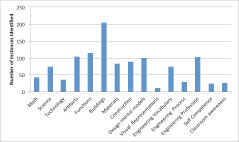
Total number of instances identifying STEM knowledge subcategories.
Seventeen STEM knowledge subcategories were identified during the analysis of the classroom field notes and the children work records.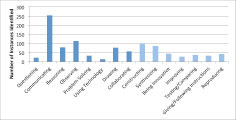
Total number of instances identifying STEM skills subcategories.
Fifteen STEM skills subcategories were identified during the analysis of the classroom field notes and the children work records. Dark blue subcategories indicate skills addressing broader developmental goals while light blue categories especially pertain to the design and engineering process.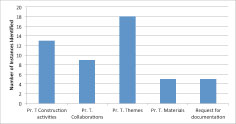
STEM dispositions subcategories and total number of instances identified in the classroom field notes and the classroom work records.
Five STEM related subcategories were identified during the analysis of the classroom field notes and the classroom work records. Childern demonstrated particular preference towards particular: a) construction activities,b) collaborations, c) working themes, d) materials, e) documentation of their work.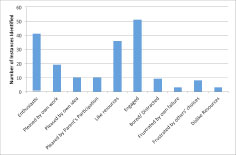
STEM feelings subcategories and total number of instances identified in the classroom field notes and the children work records.
Both positive and negative STEM-related feelings were identified during the analysis of the classroom field notes and the classroom work records. Five positive and five negative states or factors that indicate or affect feelings were further presented.Learning Overview*
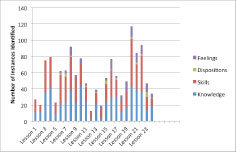
STEM learning categories as appeared through the classroom field notes.
Besides the frequency factor, dispositions and feelings were not reported early in the three-month period, but rather started to be noted after the sixth P2E class, which could probably mean that either the children’s dispositions and feelings built up over time or it took a longer time for the adults conducting the observations to be able to identify them. Another possible explanation for the late report of feelings could be that, as the P2E lessons were proceeding, the more apparent the connections between the feelings and the P2E lessons and the final construction project became.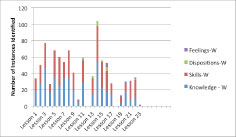
STEM learning categories as appeared through the children work records.
Not all of the instances in all of the learning subcategories were equally frequent and easy to identify. Some became apparent through the children’s discussions with other children or with the teacher. However some (almost quite as many) were discernible ONLY by careful and systematic observation, and individual discussion and documentation of the children’s work.STEM Learning*
Learning categories
Knowledge, skills, dispositions, and feelings, as defined by Katz (2000), were the four initial categories of learning identified during data analysis. Children, while exposed to multisensory input, engaged in multimodal STEM learning through discussions that directly addressed STEM content or were related to the themes of artifacts or buildings and through their participation in the EEC. Some of the learning subcategories demonstrated could be identified as newcomers, particularly those related to early engineering and STEM, while others aspects were identified as essential to early childhood education. Through further analysis of the data, while keeping a STEM perspective in mind, 15 subcategories of knowledge, 15 subcategories of skills, five subcategories of dispositions, and 10 subcategories of feelings became apparent.
Learning Overview*
Noticing the learning goals as they were identified by the classroom field notes, and the children work records, it appears that the children’s STEM knowledge and skills instances were more frequent than those indicating development of dispositions and feelings.
connection with traditional early childhood education*
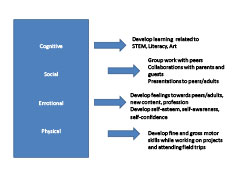
The main goal of the P2E was to promote and support the development of STEM-related learning. However, examining the curriculum, the perspective of the traditional early childhood education prism, it became apparent that it also addressed and enhanced the development of cognitive, social, emotional, and physical aspects.
*As presented in Bagiati. A. (2012) Early Engineering - A Developmentally Apropriate Curriculum for Young Children. PhD Dissertation. School of Engineering Educatin- Purdue University.
